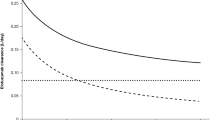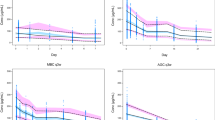Abstract
Elotuzumab is a humanized immunoglobulin G1 monoclonal antibody in development for the treatment of patients with multiple myeloma who have received one or more prior therapies. In this work, 6958 elotuzumab serum concentrations from 375 patients enrolled in four Phase 1 to 3 clinical trials were used to analyze the pharmacokinetics (PK) of elotuzumab. A population PK model with parallel linear and Michaelis–Menten elimination from the central compartment and limited-capacity target-mediated elimination from the peripheral compartment described the elotuzumab concentration–time course. Clearance of elotuzumab increased with increasing body weight and weight-based dosing generated uniform exposures across a range of body weights. Coadministration of lenalidomide/dexamethasone background therapy decreased elotuzumab nonspecific clearance by 35 %. Target-mediated elimination of elotuzumab increased with increasing baseline serum M-protein, resulting in lower exposure in patients with high baseline serum M-protein concentration. Age, race, sex, renal and hepatic function, Eastern Cooperative Oncology Group performance status, lactate dehydrogenase, albumin and β2-microglobulin had less than 20 % effect on model parameters and are unlikely to have clinically meaningful effects. Impact of anti-drug antibodies (ADAs) on the PK of elotuzumab was assessed as an ad hoc analysis. In the majority of ADA-positive patients, immunogenicity started early, was transient and resolved by 2–4 months. Since the majority of patients had ADAs detected early, this resulted in a corresponding transient increase in nonspecific clearance at these time points. Nonspecific clearance appeared to return to baseline at later time points when ADAs were no longer detected.






Similar content being viewed by others
References
Dimopoulos MA, Richardson PG, Moreau P, Anderson KC (2015) Current treatment landscape for relapsed and/or refractory multiple myeloma. Nat Rev Clin Oncol 12:42–54
Hsi ED, Steinle R, Balasa B, Szmania S, Draksharapu A, Shum BP, Huseni M, Powers D, Nanisetti A, Zhang Y, Rice AG, van Abbema A, Wong M, Liu G, Zhan F, Dillon M, Chen S, Rhodes S, Fuh F, Tsurushita N, Kumar S, Vexler V, Shaughnessy JD Jr, Barlogie B, van Rhee F, Hussein M, Afar DE, Williams MB (2008) CS1, a potential new therapeutic antibody target for the treatment of multiple myeloma. Clin Cancer Res 14:2775–2784
Veillette A, Guo H (2013) CS1, a SLAM family receptor involved in immune regulation, is a therapeutic target in multiple myeloma. Crit Rev Oncol Hematol 88:168–177
Collins SM, Bakan CE, Swartzel GD, Hofmeister CC, Efebera YA, Kwon H, Starling GC, Ciarlariello D, Bhaskar S, Briercheck EL, Hughes T, Yu J, Rice A, Benson DM Jr (2013) Elotuzumab directly enhances NK cell cytotoxicity against myeloma via CS1 ligation: evidence for augmented NK cell function complementing ADCC. Cancer Immunol Immunother 62:1841–1849
Mould DR, Sweeney KR (2007) The pharmacokinetics and pharmacodynamics of monoclonal antibodies—mechanistic modeling applied to drug development. Curr Opin Drug Discov Devel 10:84–96
Dostalek M, Gardner I, Gurbaxani BM, Rose RH, Chetty M (2013) Pharmacokinetics, pharmacodynamics and physiologically-based pharmacokinetic modelling of monoclonal antibodies. Clin Pharmacokinet 52:83–124
Japanese study of BMS-901608 (elotuzumab) in combination with lenalidomide and low dose dexamethasone (2015) https://clinicaltrials.gov/ct2/show/NCT01241292. Accessed 25 June 2015
Study of elotuzumab in combination with lenalidomide and dexamethasone in subjects with multiple myeloma and various levels of renal function (2015) https://clinicaltrials.gov/ct2/show/NCT01393964. Accessed 25 June 2015
Biomarker study of elotuzumab in high risk smoldering myeloma (2015) https://clinicaltrials.gov/ct2/show/NCT01441973. Accessed 25 June 2015
Phase III study of lenalidomide and dexamethasone with or without elotuzumab to treat relapsed or refractory multiple myeloma (ELOQUENT-2) (2015) https://clinicaltrials.gov/ct2/show/NCT01239797. Accessed 25 June 2015
Beal SL, Sheiner LB, Boeckmann AJ, Bauer RJ (2014) NONMEM Users Guides. 1989–2011. Icon Development Solutions, Hanover, Maryland
Ramalingam SS, Kummar S, Sarantopoulos J, Shibata S, LoRusso P, Yerk M, Holleran J, Lin Y, Beumer JH, Harvey RD, Ivy SP, Belani CP, Egorin MJ (2010) Phase I study of vorinostat in patients with advanced solid tumors and hepatic dysfunction: a National Cancer Institute Organ Dysfunction Working Group Study. J Clin Oncol 28:4507–4512
Stevens LA, Claybon MA, Schmid CH, Chen J, Horio M, Imai E, Nelson RG, Van Deventer M, Wang HY, Zuo L, Zhang YL, Levey AS (2011) Evaluation of the Chronic Kidney Disease Epidemiology Collaboration equation for estimating the glomerular filtration rate in multiple ethnicities. Kidney Int 79:555–562
Kass RE, Raftery AE (1995) Bayes factors. J Am Stat Assoc 90:773–795
Savic RM, Karlsson MO (2009) Importance of shrinkage in empirical Bayes estimates for diagnostics: problems and solutions. AAPS J 11:558–569
Committee for Medicinal Products for Human Use (CHMP), European Medicines Agency (2007) Guideline on reporting the results of population pharmacokinetic analyses. http://www.ema.europa.eu/docs/en_GB/document_library/Scientific_guideline/2009/09/WC500003067.pdf. Accessed 25 June 2015
Bergstrand M, Hooker AC, Wallin JE, Karlsson MO (2011) Prediction-corrected visual predictive checks for diagnosing nonlinear mixed-effects models. AAPS J 13:143–151
Gibiansky L, Gibiansky E, Kakkar T, Ma P (2008) Approximations of the target-mediated drug disposition model and identifiability of model parameters. J Pharmacokinet Pharmacodyn 35:573–591
Ette EI, Williams PJ, Kim YH, Lane JR, Liu MJ, Capparelli EV (2003) Model appropriateness and population pharmacokinetic modeling. J Clin Pharmacol 43:610–623
Tai YT, Dillon M, Song W, Leiba M, Li XF, Burger P, Lee AI, Podar K, Hideshima T, Rice AG, van Abbema A, Jesaitis L, Caras I, Law D, Weller E, Xie W, Richardson P, Munshi NC, Mathiot C, Avet-Loiseau H, Afar DE, Anderson KC (2008) Anti-CS1 humanized monoclonal antibody HuLuc63 inhibits myeloma cell adhesion and induces antibody-dependent cellular cytotoxicity in the bone marrow milieu. Blood 112:1329–1337
AbbVie Inc. (2014) HUMIRA (adalimumab) Prescribing Information. AbbVie Inc., North Chicago, IL. http://www.rxabbvie.com/pdf/humira.pdf. Accessed 25 June 2015
Fasanmade AA, Adedokun OJ, Ford J, Hernandez D, Johanns J, Hu C, Davis HM, Zhou H (2009) Population pharmacokinetic analysis of infliximab in patients with ulcerative colitis. Eur J Clin Pharmacol 65:1211–1228
Fasanmade AA, Adedokun OJ, Blank M, Zhou H, Davis HM (2011) Pharmacokinetic properties of infliximab in children and adults with Crohn’s disease: a retrospective analysis of data from 2 phase III clinical trials. Clin Ther 33:946–964
Study of bortezomib and dexamethasone with or without elotuzumab to treat relapsed or refractory multiple myeloma (2015) https://clinicaltrials.gov/ct2/show/NCT01478048. Accessed 25 June 2015
Acknowledgments
This study was funded by Bristol-Myers Squibb, Princeton, NJ, USA. Editorial assistance was provided by Joanne Tang at Caudex and was supported by Bristol-Myers Squibb.
Author information
Authors and Affiliations
Corresponding author
Additional information
Leonid Gibiansky and Chaitali Passey have contributed equally to this work.
Electronic supplementary material
Below is the link to the electronic supplementary material.
Rights and permissions
About this article
Cite this article
Gibiansky, L., Passey, C., Roy, A. et al. Model-based pharmacokinetic analysis of elotuzumab in patients with relapsed/refractory multiple myeloma. J Pharmacokinet Pharmacodyn 43, 243–257 (2016). https://doi.org/10.1007/s10928-016-9469-x
Received:
Accepted:
Published:
Issue Date:
DOI: https://doi.org/10.1007/s10928-016-9469-x




